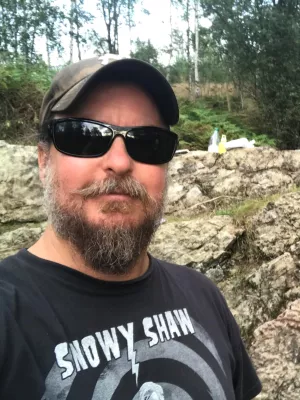
Mats Eriksson
Professor

Baring it all- undressing Cambrian ´Orsten´phosphatocopine arthropods using synchrotron X-ray tomographic microscopy
Författare
Summary, in English
Synchrotron radiation X-ray tomographic microscopy (SRXTM) was used to virtually dissect and peel the shields off of the microscopic, bivalved phosphatocopine crustaceans in the Cambrian ‘Orsten’ type of preservation of Sweden. Doing so opened up for an array of concealed internal structures to be observed in a fully enclosed specimen of Hesslandona ventrospinata and a semi-enclosed specimen of Hesslandona angustata. For comparison, also a head-larva stage specimen of H. angustata, with shields in ‘butterfly position’, was analysed. The X-ray tomographic data sets revealed excellently preserved structures, such as labrum, sternum, antennae, mandibular and post-mandibular limbs with their minute setae, all of which were more or less dis-
guised by the enclosing shields. This, moreover, allowed assignment to growth stages of the specimens, which is impossible based solely on external morphology and size.
Microspherules observed inside the shields of the semi-enclosed H. angustata specimen may represent remains of food particles, and the feeding biology of phosphatocopines is discussed in detail. Our analyses suggest that phosphatocopines were particle feeders. The SRXTM technique offers the ability to three-dimensionally reconstruct the morphology in high resolution, construct virtual serial sections and study concealed structures. The resulting data allow for new structures to be revealed for previously known taxa and for new taxa to be identified, with the added benefit of not destroying the specimens in the process. Hence, we do not longer have to rely on serendipitous finds of broken and/or open phosphatocopine specimens to elucidate their diagnostic ventral morphology.
guised by the enclosing shields. This, moreover, allowed assignment to growth stages of the specimens, which is impossible based solely on external morphology and size.
Microspherules observed inside the shields of the semi-enclosed H. angustata specimen may represent remains of food particles, and the feeding biology of phosphatocopines is discussed in detail. Our analyses suggest that phosphatocopines were particle feeders. The SRXTM technique offers the ability to three-dimensionally reconstruct the morphology in high resolution, construct virtual serial sections and study concealed structures. The resulting data allow for new structures to be revealed for previously known taxa and for new taxa to be identified, with the added benefit of not destroying the specimens in the process. Hence, we do not longer have to rely on serendipitous finds of broken and/or open phosphatocopine specimens to elucidate their diagnostic ventral morphology.
Avdelning/ar
- Berggrundsgeologi
- Kärnfysik
- Funktionell zoologi
Publiceringsår
2016
Språk
Engelska
Sidor
312-326
Publikation/Tidskrift/Serie
Lethaia
Volym
49
Issue
3
Fulltext
Dokumenttyp
Artikel i tidskrift
Förlag
Taylor & Francis
Ämne
- Zoology
- Geosciences, Multidisciplinary
Nyckelord
- feeding biology
- Phosphatocopina
- SRXTM
- ventral morphology
Status
Published
ISBN/ISSN/Övrigt
- ISSN: 0024-1164

